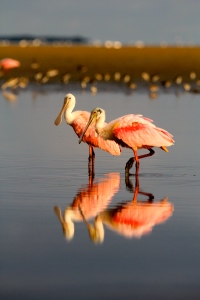The Central Everglades Planning Project is Audubon’s top Everglades priority and the most ambitious element of restoration to date.
Known as “CEPP,” this effort seeks to tackle some of the most difficult challenges for the Southern Everglades and Florida Bay.
At its core, CEPP will aid in getting more water to flow south into Everglades National Park. This is critical to improving habitat in Florida Bay for roseate spoonbills and other wildlife. In combination with other restoration efforts, such as the Tamiami Trail and C-111 projects, the benefits of CEPP are even greater.
Recent media attention has focused on the failed attempt to make the project eligible for funding. Delays in completing the plan for CEPP need to be resolved as soon as possible so we don’t miss the next opportunity. But residents of the Keys should not lose sight of this project’s immense benefit to Florida Bay.
In April, the Everglades Foundation and Everglades Law Center hosted programs in Key Largo and Key West. I was one of five scientists who gave presentations about the positive impact of CEPP on the Florida Keys. The impetus for these programs was persistent rumors that CEPP will damage the Keys marine environment by injecting polluted water into Florida Bay, similar to what happened in the Indian River Lagoon and the Caloosahatchee Estuary last summer.
Simply put, those rumors are false.
The wetlands in this area act as filters, removing phosphorus and nitrogen from the water as it flows south. This means the freshwater that ends up in Florida Bay is clean and of good quality. This is not the same as it is on Florida’s east and west coasts, where polluted water from Lake Okeechobee is directly injected into the estuaries by a canal system.
In short, decades of diverting freshwater away from Florida Bay has resulted in severe damage to the birds, fish and wildlife of our area. The only way to correct this situation is to restore the proper timing, distribution, quantity and quality of freshwater to Florida Bay. CEPP is designed to do just that.
Make no mistake about it; more freshwater is good for Florida Bay. CEPP will improve this beautiful estuarine ecosystem and increase biological productivity. This means more fish in the water and more birds in the sky. And more visitors, too.
Tourists drive our economy by renting our charter boats, dining on our world-class seafood and by spending time viewing our incredible abundance of wildlife.
It is a misconception that Everglades restoration could somehow harm the Keys. Florida Bay absolutely needs water from the Everglades and CEPP is the best way to ensure this water gets here clean. No more delays; CEPP must move forward as soon as possible.
Dr. Jerry Lorenz is Audubon Florida’s state director of research. He works in Tavernier.




















